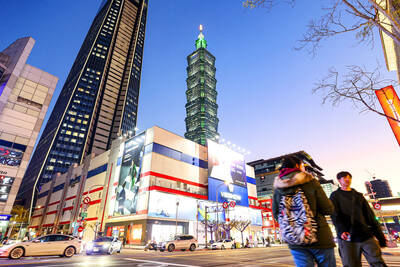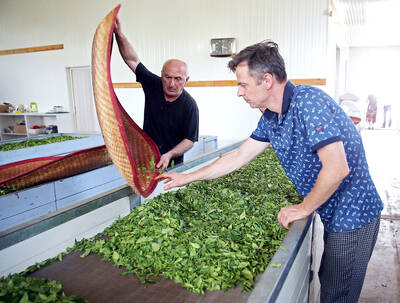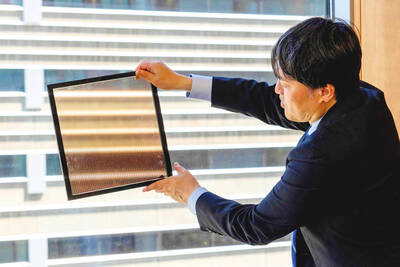Long stuck at a red light in India, French automaker Renault has fresh plans to conquer the country’s explosively growing car market with a revitalized local partnership and a low-cost vehicle.
Renault and its Japanese partner Nissan are set to join in 2012 the crowd of manufacturers producing low-cost cars for India in a bid to challenge the Tata Nano, the world’s cheapest automobile.
“I don’t want Renault and Nissan to be makers of very pretty cars people dream about but can’t afford,” Carlos Ghosn, who runs the Franco-Japanese car-making alliance Renault Nissan, said in New Delhi last week.

PHOTO: AFP
“We need an entry price that’s very competitive,” Ghosn said, declaring plans were on track with the alliance’s Indian partner Bajaj to roll out the car — dubbed ULC for “ultra low cost” — albeit a year behind schedule.
India’s Tata Motors set a new floor globally for car prices when it launched the snub-nosed Nano, whose price starts at around 115,000 rupees (US$2,480). The four-door hatchback mini-car hit Indian roads earlier this year.
Ghosn, who has made the cheap car a pet project, kept mum about the showroom price when he spoke on the sidelines of an economic conference.
But he said the cost of the car would be “amazing” and “lower than any car today made in India” when taking into account fuel and other running expenses.
Renault-Nissan had earlier pegged the price in the US$2,500 to US$3,000 range.
The car will be designed and made by top Indian motorbike and rickshaw maker Bajaj Auto and marketed by the Renault Nissan Alliance, which accounts for just 1 percent of sales in India.
“We’ve a clear definition of who does what,” Ghosn said, announcing differences with Bajaj that held up the project had been resolved.
Up to 80 percent of the internal car components are expected to be shared with Bajaj’s two and three-wheelers, making manufacturing less costly.
“Bajaj is an eminently good choice to make this car as it will be something between a motorcycle and conventional car,” Indian motoring columnist Murad Ali Baig said.
Renault’s other lone foray in the Indian market has been the four-door Logan, built with another Indian partner, top utility vehicle maker Mahindra and Mahindra, aimed at the mid-size segment.
But the Logan, launched in 2007, has found few buyers, panned by critics for its “dated looks” and high price.
“We had no illusions when we came to India [that] we would get it right the first time,” Ghosn said.
When the Logan was released, Renault aimed to sell 30,000 cars a year. But sales have been one-fifth of that and the Renault-Mahindra partnership posted a loss of 4.9 billion rupees in the last financial year.
Renault, which owns 44 percent of Nissan, believes it needs critical mass in India to drive global growth.
“The cheap car [segment] is a sensible entry point for them but we have to see what their plans are like,” Emkay Shares and Stock Brokers analyst Chirag Shah said.
The Indian market — forecast to triple to 6 million cars annually from 2 million in a decade — is fast turning into a global battleground as carmakers seek new growth regions to offset anaemic Western sales.
Indian car sales last month rocketed by 34 percent to 132,615 units, according to industry figures released last week.

UNCERTAINTIES: Exports surged 34.1% and private investment grew 7.03% to outpace expectations in the first half, although US tariffs could stall momentum The Chung-Hua Institution for Economic Research (CIER, 中華經濟研究院) yesterday raised its GDP growth forecast to 3.05 percent this year on a robust first-half performance, but warned that US tariff threats and external uncertainty could stall momentum in the second half of the year. “The first half proved exceptionally strong, allowing room for optimism,” CIER president Lien Hsien-ming (連賢明) said. “But the growth momentum may slow moving forward due to US tariffs.” The tariff threat poses definite downside risks, although the scale of the impact remains unclear given the unpredictability of US President Donald Trump’s policies, Lien said. Despite the headwinds, Taiwan is likely

When Lika Megreladze was a child, life in her native western Georgian region of Guria revolved around tea. Her mother worked for decades as a scientist at the Soviet Union’s Institute of Tea and Subtropical Crops in the village of Anaseuli, Georgia, perfecting cultivation methods for a Georgian tea industry that supplied the bulk of the vast communist state’s brews. “When I was a child, this was only my mum’s workplace. Only later I realized that it was something big,” she said. Now, the institute lies abandoned. Yellowed papers are strewn around its decaying corridors, and a statue of Soviet founder Vladimir Lenin

UNIFYING OPPOSITION: Numerous companies have registered complaints over the potential levies, bringing together rival automakers in voicing their reservations US President Donald Trump is readying plans for industry-specific tariffs to kick in alongside his country-by-country duties in two weeks, ramping up his push to reshape the US’ standing in the global trading system by penalizing purchases from abroad. Administration officials could release details of Trump’s planned 50 percent duty on copper in the days before they are set to take effect on Friday next week, a person familiar with the matter said. That is the same date Trump’s “reciprocal” levies on products from more than 100 nations are slated to begin. Trump on Tuesday said that he is likely to impose tariffs

Japan is heavily investing in a new kind of ultra-thin, flexible solar panel that it hopes will help it meet renewable energy goals while challenging China’s dominance of the sector. Pliable perovskite panels are perfect for mountainous Japan, with its shortage of flat plots for traditional solar farms. A key component of the panels is iodine, something Japan produces more of than any country but Chile. The push faces some obstacles: Perovskite panels contain toxic lead, and, for now, produce less power and have shorter lifespans than their silicon counterparts. Still, with a goal of net zero by 2050 and a desire to